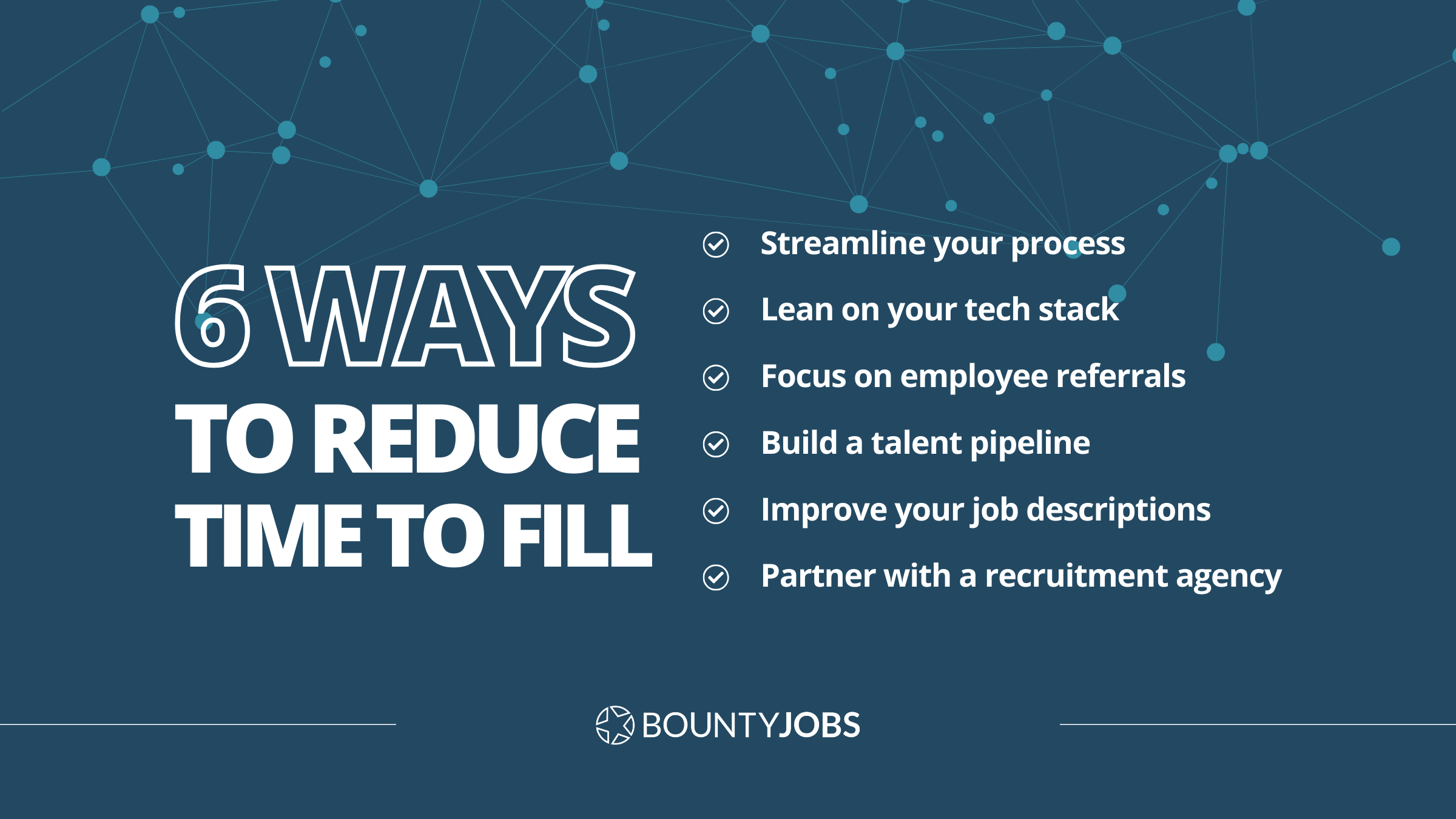6 min read
Quick Hires, Quality Talent: 6 Ways to Reduce Time to Fill
 Cassie Adams
:
November 03, 2023
Cassie Adams
:
November 03, 2023

I'm sure this isn't a surprise—filling open positions quickly is super important to your organization, regardless of size or industry.
After all, a position that stays vacant for too long can seriously hurt your company's productivity and revenue. That's why reducing the time it takes to fill a position is a top priority for many of the employers we work with.
In this article, we'll explore six ways to reduce time to fill and find the right candidates in less time. We'll dive into each strategy so you can put them into action and get results.

Why is time to fill important?
Before we dive into strategies for reducing time to fill, let's first understand why it's important.
Cost savings
The longer a position remains open, the more it costs your company in terms of lost productivity and revenue.
According to a study by SHRM, the average cost-per-hire is $4,129, and the average time-to-fill is 42 days. This means that every day a position remains open, it costs your company an average of $98.07.
By reducing time to fill, you can save your company thousands of dollars in recruitment costs.
competitive advantage
In today's highly competitive job market, employers are constantly vying for top-notch talent. As a result, every day counts when it comes to filling open positions.
Basically, if your company's recruitment process is too slow, you run the risk of losing the most qualified candidates to your competitors.
By streamlining the hiring process and reducing the time it takes to fill a position, you can increase your chances of securing the best talent before they receive offers from other companies.
improved candidate experience
A lengthy recruitment process can be frustrating for candidates, leading to a negative candidate experience—potentially damaging your employer brand and make it harder to attract top talent in the future.
By reducing time to fill, you can improve the candidate experience and leave a positive impression on potential employees.

Strategies for Reducing Time
to Fill
Now that we understand the critical role that reducing time to fill plays in optimizing your recruitment process, let's dive into six actionable strategies designed to help you achieve this goal more efficiently.
These tactics not only speed up hiring, but also ensure you're bringing the best talent on board.
1️⃣: Streamline your recruitment process
One of the most effective ways to reduce time to fill is to fine-tune your recruitment process from start to finish.
Begin by conducting a thorough audit of your existing workflow. Are there redundant interviews? Is your team waiting days for approval from higher-ups? Pinpoint these delay-inducing elements to get a clear picture of where your process is lagging.
Once you've identified any bottlenecks, consider implementing automation tools that can handle repetitive tasks like resume screening or appointment scheduling. This frees up your team to focus on more strategic aspects of recruitment, such as candidate engagement and interviews.
2️⃣: optimize your tech stack
Technology can be a powerful tool for reducing time to fill in recruitment. The market is flooded with recruitment software and tools designed to automate tasks, enhance workflows, and boost overall efficiency.
But it's crucial to choose the right tools that align with your specific needs—which, in this case, is reducing your time to fill.
You'll want to consider solutions that either automate, replace, or speed up your existing processes.
Take an Applicant Tracking System (ATS), for instance—this isn't just a digital filing cabinet for resumes. A robust ATS can categorize candidates based on specific skills, years of experience, or even answers to screening questions.
This allows your team to quickly identify high-potential candidates and move them through the pipeline at an accelerated pace.
Another time saver? Consider adding video interviewing platforms. These often come with features like automated scheduling, AI-driven assessments, and even on-the-spot coding tests for technical roles, and they can facilitate first-round interviews, saving valuable time for both your team and candidates.
Analytics tools can provide real-time insights into your recruitment funnel, helping you identify not just bottlenecks but also trends, like when candidates are most likely to drop out of the process. This data can help you make informed decisions about where your process needs help.

3️⃣: focus on employee referrals
Your employees—even the ones outside of HR and TA—are the ultimate talent sourcers.
They know your culture inside out and can identify candidates who would thrive there, which is why employee referrals should be one core piece of your TA strategy.
Referred candidates tend to have higher retention rates and fill positions faster than other recruiting methods. They come vetted and are already sold on your company from the trusted source of your own team.
So how can you motivate your staff to send top talent your way? There are a lot of ways you can build, test, and optimize a referral program, but some of the key components are:
- Ask for specific recommendations instead of general referrals
- Offer an enticing referral bonus or incentive program (even a simple perk like gift cards or extra PTO can get employees excited)
- Gamify your referral program to keep it exciting
- Make it easy for your everyone, but especially the employees that will be referring talent—create a streamlined process through your ATS and promote it internally
Leaning on employee referrals is truly a win-win. You reduce time and costs while sourcing quality candidates who will thrive.
And, importantly, your employees feel valued as partners in building an outstanding workforce.
4️⃣: BUILD A TALENT PIPELINE
When a position opens up, every day it sits vacant is money left on the table. But who has time for a lengthy talent search when priorities are already piled high?
This is exactly where a talent pipeline is helpful.
A talent pipeline is like a little black book of pre-screened, qualified candidates you can call on when a role needs filling. Instead of scrambling to source and vet applicants, your next hire is already right at your fingertips!
So how do you go about cultivating this pool of talent?
- Attend virtual or in-person job fairs and conferences to connect with potential candidates in your industry
- Chat up new connections on LinkedIn
- Scout online communities and forums related to your field
The goal is to nurture relationships before you have an immediate opening.
When you eventually post the job, you'll have a running start reaching out to your leads. And since you've already established rapport, these promising prospects are far more likely to raise their hand.
Maintaining a talent pipeline is a bit of legwork upfront, but it pays off in faster, more efficient hiring when your team needs to scale quickly.
5️⃣: improve your job descriptions
Your job listing is a candidate's first impression of your company. Is your description communicating an exciting opportunity that top talent would be thrilled to fill? Or is it a dense block of text that blends into the crowd?
Crafting compelling job posts is an art. You want to highlight the unique challenges and growth opportunities the role offers. Use vivid language that gets candidates excited and envisioning themselves in the position.
Structure your description clearly, with an engaging overview followed by concise sections covering must-have qualifications, responsibilities, benefits, and company culture. Break up walls of text with bullet points for better readability.
Sprinkle in relevant keywords to get your listing noticed in applicant searches. But avoid overusing jargon - keep it conversational. A human-centered tone and inclusive language can attract a more diverse pool of applicants.
Avoid unconscious bias by focusing on necessary skills vs. credentials. And don't overinflate requirements—studies show women and people of color are less likely to apply to jobs demanding unnecessary qualifications.
Take time to optimize your jobs listings, and you'll reel in great candidates who get jazzed reading about your company. Your next amazing hire is out there searching—make sure your description speaks to them!
📊
Stay on top of the latest talent acquisition stats!
Get the top 3 most impactful industry stats you need to know right in your inbox every 2 weeks.
Over 7,000 talent leaders rely on it to stay up to date on hiring trends, workforce insights, and data-backed recruiting strategies.
6️⃣: partner with a recruitment agency
Imagine having a secret weapon that not only speeds up your hiring process but also gives you an edge over the competition.
That's the power of teaming up with third-party recruiters and search firms.
Think of recruitment agencies as your talent scouts. They've got a treasure trove of ready-to-go, skilled candidates waiting to be matched with the right company. They're the experts at finding needles in haystacks, which means you can skip the time-consuming legwork of sourcing and screening.
And the best part—they often have connections with top talent who may not even be actively looking for a new role, but would consider a move for the right offer.
But it's not just about speed! Recruiters and search firms rely on their network of connections, so they're likely to offer quick, thoughtful communication with both the hiring employer and candidates they submit. And since they're acting as an extension of your internal TA team, this can leave a great impression on candidates.
With a platform like BountyJobs, it's like having a whole team of talent whisperers at your fingertips. We streamline working with multiple recruiters, so you can improve your time to fill without juggling multiple contracts and payments.
FINAL THOUGHTS
Reducing time to fill is crucial for any organization looking to stay competitive in today's job market. After all, every second counts—and if you're not staying ahead, you risk falling behind.
And remember, it's about finding the right person for the position, not just filling it.
By streamlining your recruitment process, bringing in some third-party help when needed, and using technology to your advantage, you can easily gain an edge in the race for top talent.
If you're looking to speed up your hiring and send your open roles out to a marketplace of search firms under one contract and one source of payment, take a look at our platform, or contact us to learn more.